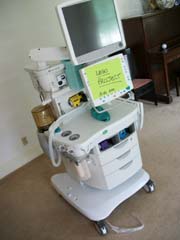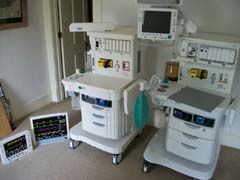 But, as is often the case, negotiations continued, and eventually we came to agreeable terms. Once I realized this project was going to happen, then more mundane issues presented themselves.
But, as is often the case, negotiations continued, and eventually we came to agreeable terms. Once I realized this project was going to happen, then more mundane issues presented themselves.

I'm sure they are hoping to hear an answer like "a giant dragon", "spaceship", or a replica of some famous skyline.
The last thing they would probably ever expect to hear is: "I'm building a full-sized anesthesia machine."
And yet, that's what I found myself doing during the summer of 2011.
I had to be talked into it. GE Healthcare had approached me in March of the year and started asking how much such a model would cost. I don't give out specific numbers on my website, but suffice it to say that my initial quote was a lot. I have not focused on building 3D sculptures for sometime now, and building a giant hospital contraption did not really pique my interest enough to change my mind.
 But, as is often the case, negotiations continued, and eventually we came to agreeable terms. Once I realized this project was going to happen, then more mundane issues presented themselves.
But, as is often the case, negotiations continued, and eventually we came to agreeable terms. Once I realized this project was going to happen, then more mundane issues presented themselves.
First, I told, them, if they really wanted an accurate clone of this machine, I would need more than a few promotional pictures. I would need an actual anesthesia machine at my studio (that is, my house). Much to my surprise, they said, "okay, what's your address?" A few weeks later I had a legitimate anesthesia machine sitting in my living room (see right, it was one that was being sent away for refurbishing -- now detoured to sit at my place for the summer). We got insurance issues settled, and I made sure they wouldn't mind of my cat decided to climb around on this thing.
And that is how, by late May of 2011 I began building the "LEGO machine" as I called it.
Most of the time was actually spent waiting for pieces to arrive (since I keep very little in inventory these days). I ordered a lot (A LOT) of white bricks. In the end the model used over 30,000 pieces.
Here is a list of links to pictures that show some of the progression of the build: